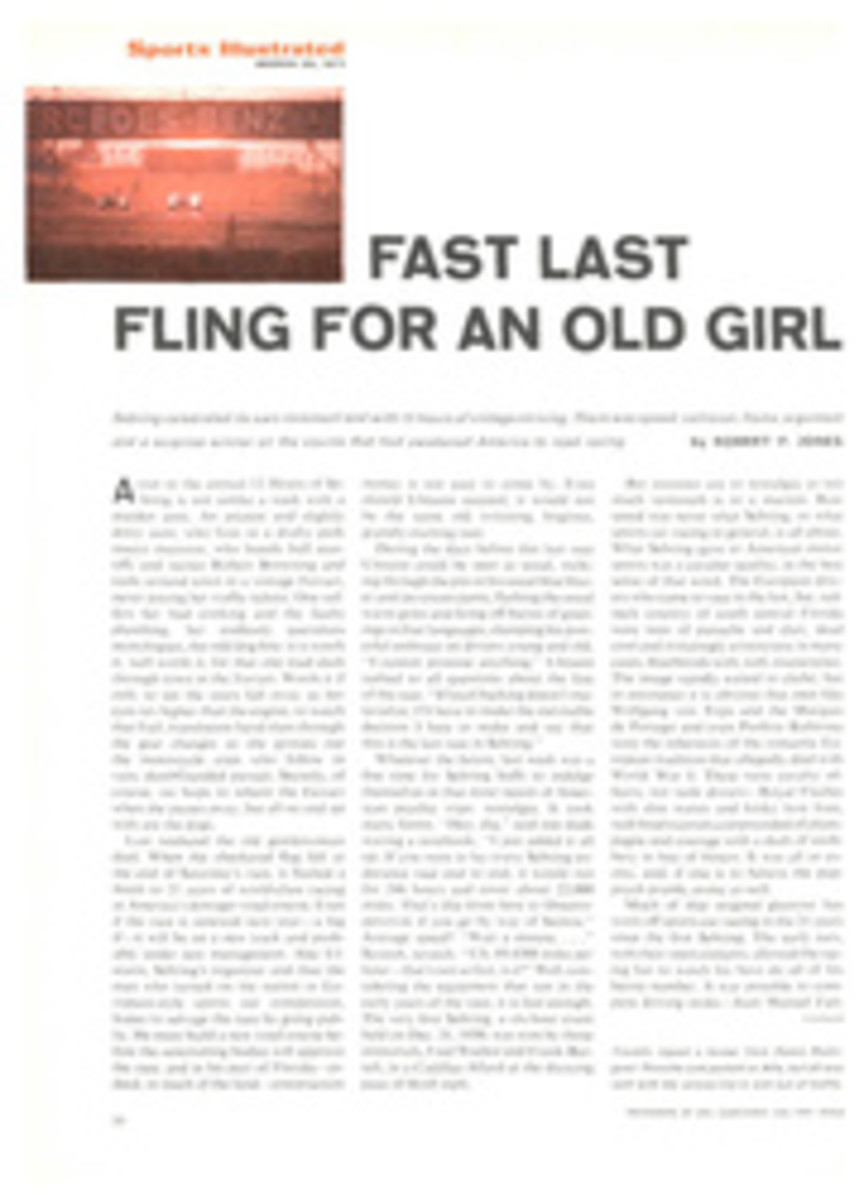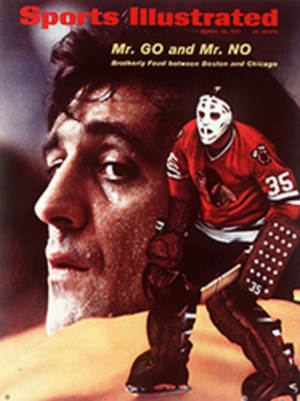
Big reach for a net profit
Rod Laver—all red-haired and freckles, with a big beak of a nose on his gaunt face—looks like some sort of prehistoric bird, but on the tennis court he flies loops and Immelmanns around the hawks and eagles of today's game, hardly ruffling his feathers in the process. Last week, having just stepped off a plane after a 10,000-mile flight from Sydney with a momentary stopover in Southern California, he rushed through a couple of routine victories on successive nights at Madison Square Garden in New York and thereby added another $50,000 to his 1971 bankroll.
It has been that way with Laver for the last couple of years. His schedule is crowded and rich. He began the month of March at a tournament in London, where he picked up $7,800 for winning. He was in Australia the Monday after for another tournament, in which he lost in the quarterfinals, and spent the following weekend at home with his wife in Corona del Mar, Calif. He arrived in Manhattan a week ago Monday for a press conference, and by 10 o'clock Friday night his earnings for the first three months of 1971 had risen to the neighborhood of $175,000 (he made slightly more than $200,000 in all of 1970), not including a few nickels and dimes from the Sydney tournament and some doubles matches that he had not yet bothered to add up. It is possible that no other athlete has made so much in so short a time—not Arnold Palmer, not Willie Shoemaker, perhaps not even Muhammad Ali or Joe Frazier if you figure in all the months it takes a boxer to get ready for his payday.
Plainly the big money in sport is beginning to rub off on tennis—or began to a couple of years ago, as Laver reminds one. But it is not yet obvious why. The rally, which is what tennis is all about, was bombed out of men's singles about the time of Pearl Harbor. Now it is serve, run to the net, put it away; serve, run to the net, put it away. Unless Pancho Gonzales, the supreme tragedian of tennis, happens to be on the card, a really big gate will find 10,000 people in the stands (there were fewer than 9,000 for each of the two nights at the Garden last week, though a lot of those in attendance did pay the $10 top price). In the smaller towns pro tennis is delighted to find 3,000 to 4,000 in the house.
None of this daunts an intrepid man like Fred J. Podesta. It was he who put up the $210,000 for the Tennis Champions Classic, which is the name of the event that Laver won. Podesta is a former Garden official who got hooked on pro tennis in the days when Jack Kramer used to comb the sticks in a beat-up station wagon with an opponent, a rolled-up piece of canvas for a court and a couple of has-beens for doubles. Last year Podesta introduced the Classic, which involves a 16-match competition among nine pros. There is a $10,000 winner-take-all prize for each of the matches until the semifinals, where the purse is split $15,000 and $5,000 apiece for the two winners and losers, in the finals the winner gets $35,000, the loser $15,000. Laver, of course, won it last year, and Podesta was happy enough with the results to try again.
The first problem in a promotion of this kind is to get your nine pros. The best are now under contract to World Championship Tennis, a Dallas outfit owned by Lamar Hunt and Al G. Hill Jr. They have their own deal, which consists of 20 tournaments throughout the year with a purse of $45,000 apiece and a grand finale at the end for $100,000. If you are Podesta, you go to Hunt and Hill and ask when you may borrow nine of their chaps, and they give you a number of dates beginning on Jan. 2 and finishing March 19.
Then you pick the pros you think will arouse a dozing public. Laver (the Rocket) naturally, Tom Okker (the Flying Dutchman), Roy Emerson ("venerable 34-year-old Australian"), John Newcombe (1970 Wimbledon champion), Ken Rosewall (1970 U.S. Open champion), Tony Roche (1970 U.S. pro champion), Arthur Ashe (new pro), Roger Taylor (English) and Gonzales, except that Gonzales can't accept because he is flirting with a rival setup of the U.S. Lawn Tennis Association and claims that he no longer belongs to Hunt and Hill. So in his place you get Dennis Ralston (Dennis the Menace). Next you book single dates at arenas in Boston, Rochester, New Haven and Philadelphia, plus two in Detroit and Los Angeles and nine at Madison Square Garden.
The scene is set, and Laver starts the new year by beating Rosewall in straight sets at the Garden. Two and a half months later Laver is again at the Garden, standing in front of the umpire's chair and receiving an outsized replica of a check for $160,000, which is not exactly the way he really gets paid but it presses home the money point as the flashbulbs pop. Laver accumulated the $160,000 by winning 13 straight matches, a streak that included two victories over Ashe, two over Emerson, two over Ralston and three over Okker. At this point it becomes too complicated to explain why, in reducing nine players to one, it is necessary for Laver to beat so many of them so often. Suffice it to say that Laver won 39 sets and lost only 10, which is evidence enough that no one is in his class today when his mind is on winning.
As for the real money, Podesta mails that to World Champion Tennis after each match, and it shows up in the check that each of the pros later receives from Hunt and Hill. Perhaps it is only natural in a game where some points are worth 15, some 10 and some only one that a fellow should have to go through such convolutions to earn a buck.
Laver seems not to mind it at all. "The money is good," he explains for the benefit of those who can't count, and he tries as hard as he can to emit the kind of charm that makes a sports hero the idol of millions. It is not easy, for Rod was raised in the Harry Hop-man school of Australian tennis where a small grunt is the only communication allowed between player and public. Does he dislike the weekly intercontinental commuting his profession demands? "No. The chap you're playing against has probably made the same trip." Is traveling a major problem, what with arranging all the airline tickets and hotel reservations and currency changes? "No. Have you ever heard of the American Express credit card?"
Thus it is that Laver is obliged to express his personality through his performance, and certainly no one since William T. Tilden II has had the variety and subtlety of strokes to do it with. For a superior athlete Laver is a small man, no taller than Little Bill Johnston, who always seemed so slight and frail when he played against the likes of Big Bill Tilden. But at 5'8½" and 155 pounds, Laver's body is as hard as an ingot, and his left arm, beginning at the shoulder, would be an asset to a stevedore.
In some ways Laver's size is his advantage. His speed and quickness on the court are such that only a most extraordinary placement is beyond his reach. His assortment of shots—top spin, slice, flat, drop shot, volley, smash, drop volley—far exceeds the repertoire of any modern player, most of whom were raised on the theory that the big serve, volley and smash could get the job done.
In his final match with Okker, Laver demonstrated the value of his exceptional versatility. Okker began the match aggressively, running off the first three games after breaking Laver's first serve. His cross-court backhand was scoring clean placements, sometimes flat and with great speed, sometimes with looping top spin. But Laver quickly shifted the attack to Okker's forehand, and, as he quietly explained afterward, "Tom was having such great success with his backhand that he may have eased up a bit on his forehand."
Laver evened the set, but Okker never looked like losing until they reached 5-all and went into the 12-point, sudden-death playoff now used by the pros. Here Laver, with all his art and craft, called on shots that only he owns—crowding Okker's big serve and putting it away untouched, letting out the full power of his own big serve, leading Okker into positions so awkward that his shots were easy prey. After the sudden-death reached 2-2, Laver ran off the next five points as if he suddenly remembered he had an important engagement elsewhere. The match was as good as over, and Laver completed the next two sets with the loss of only three games. Okker conceded it all was inevitable. Like the other pros, he knows that no one beats Laver when his game is in shape, and, as Laver pointed out, "I played some of the best tennis I've ever played at the right time."
The rest of the pros might as well get used to this sort of thing because Rod Laver enjoys what he is doing, particularly the money part. What with his endorsements—mostly clothes and equipment—and what he intends to win in the remaining tournaments of the year, his income may reach $400,000. And Rod, at the age of 32, is not even thinking about retirement. He does not live high—there is hardly time for that—so what do you do with so much money? "I like to invest it," he says.
PHOTO
PHOTO
THE NIGHT'S WORK WAS WORTH $35,000. OTHER CHECK IS FOR SYMBOLIC $160,000

